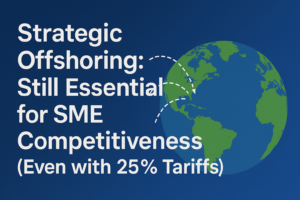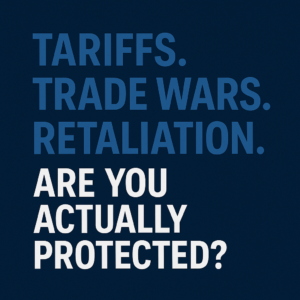
Executive Summary
In today’s rapidly evolving electronics and technology manufacturing sector, companies face mounting pressure to reduce costs, enhance product quality, and optimize production cycles—all while safeguarding intellectual property and streamlining supply chains. Engaging a specialized Design for Manufacturing (DFM) engineering firm to refine product designs for manufacturing, material science, logistics, and inspection—coupled with fully managed offshore manufacturing in non-tariff regions such as India and Vietnam—presents an innovative solution to these challenges.
This white paper details how third-party DFM specialty engineering can substantially lower the cost of goods sold (COGS), boost product quality and reliability, and reduce warranty costs. It also explores the significant labor and operational cost differences between North American manufacturing and offshore facilities, emphasizing the technological advancements, including Industry 4.0 solutions, that enable superior quality in offshore production. Additionally, the paper discusses why a fully managed offshore manufacturing program is strategically advantageous compared to internal or local production and presents a detailed framework for selecting the best SKUs to offshore based on volume.
Drawing on insights from leading authorities such as McKinsey, Deloitte, and IEEE, as well as real-world case studies from the electronics and technology manufacturing industry, this paper provides C-suite executives with a comprehensive, data-driven analysis to support informed decision-making regarding offshoring and process optimization.
Introduction
Industry Context
The electronics and technology manufacturing industry is characterized by rapid innovation, short product life cycles, and intense global competition. Manufacturers are continuously challenged to produce increasingly complex products while managing rising costs, supply chain disruptions, and quality expectations. As companies seek to balance these demands, the integration of specialized engineering services and offshore manufacturing has emerged as a transformative approach.
The Role of DFM in Electronics Manufacturing
Design for Manufacturing (DFM) is a systematic methodology aimed at designing products for ease of production, assembly, and quality control. In the electronics sector, DFM is particularly critical due to the high complexity of products, stringent quality standards, and the rapid pace of technological change. A third-party DFM specialty engineering firm brings expertise in several key areas:
- Material Science: Optimizing material selection (e.g., advanced composites, high-performance polymers, lightweight metals) to reduce weight, enhance durability, and minimize costs.
- Design for Logistics: Streamlining product designs to simplify packaging, transportation, and distribution.
- Design for Inspection: Integrating quality control measures early in the design phase to reduce defects and warranty claims.
By refining product designs along these lines, companies can reduce waste, improve reliability, and achieve significant cost savings.
The Offshore Manufacturing Advantage
In parallel with optimized design, offshore manufacturing in countries such as India and Vietnam offers a powerful strategy for cost reduction. Non-tariff regions benefit from lower labor costs, modern production facilities, and rapidly evolving Industry 4.0 capabilities. High-quality, fully managed offshore manufacturing programs can provide:
- Substantial Operational Cost Savings: With labor and overhead costs that can be as low as 20–30% of those in North America.
- Advanced Production Technologies: Integration of automation, robotics, and IoT solutions that ensure consistent quality.
- Enhanced Scalability: Flexible production capabilities that allow manufacturers to scale operations efficiently.
This white paper examines the financial, technological, business, and quality benefits of engaging DFM specialty engineering and pairing these efficiencies with offshore production.
Section 1: Financial Benefits – Reducing COGS and Lowering Warranty Costs
Impact of DFM on Reducing COGS
The role of a third-party DFM specialty engineering firm is to optimize product designs to ensure manufacturability, reduce complexity, and enhance reliability. These improvements translate into significant financial benefits:
- Material Cost Reduction: By leveraging advanced material science, DFM engineers can substitute traditional materials with high-performance alternatives. For instance, replacing conventional plastics with high-performance polymers or incorporating advanced composites can lower material costs and reduce weight, which further reduces shipping and handling expenses. Recent studies in electronics manufacturing have shown that such material optimizations can reduce material costs by 10–15%[^1].
- Simplified Assembly Processes: Optimized designs reduce the number of components and the complexity of assembly. This simplification minimizes production errors, decreases assembly time, and reduces the labor required per unit. Companies have reported up to a 20% decrease in assembly costs after implementing DFM principles[^2].
- Reduced Scrap and Rework: By designing for inspection and quality control from the outset, DFM strategies help minimize production defects. The implementation of rigorous design reviews and failure mode analysis can lower scrap rates by 25% and reduce rework costs significantly, resulting in lower overall COGS.
Warranty Cost Reduction and Reliability Improvements
Warranty claims represent a major cost for electronics manufacturers. Enhancing product design through DFM can directly impact warranty costs:
- Early Defect Detection: DFM methods integrate comprehensive testing and inspection protocols during the design phase. This proactive approach ensures that potential issues are identified and addressed before production begins, reducing field failures.
- Enhanced Product Reliability: Products engineered with DFM principles exhibit higher consistency and reliability. In real-world case studies from the electronics sector, companies have noted a 15–25% reduction in warranty claims when DFM strategies were employed[^3].
- Lifecycle Cost Management: Improved design leads to longer-lasting products, reducing the frequency and cost of after-sales service. By reducing the number of warranty claims, companies can achieve better customer satisfaction and a stronger market reputation.
Material Science Examples in Electronics
In electronics manufacturing, material selection plays a critical role in product performance and cost management. Consider the following examples:
- Advanced Composites: These materials offer high strength-to-weight ratios and excellent thermal stability, which are crucial for high-performance electronic devices. Using composites in circuit board enclosures and other components can reduce weight and improve durability, resulting in lower shipping costs and enhanced product longevity.
- High-Performance Polymers: Polymers engineered for high-temperature performance and chemical resistance are essential in environments where electronics are exposed to harsh conditions. By selecting such materials, manufacturers can extend product lifecycles and reduce the frequency of warranty claims.
- Lightweight Metals: The use of aluminum and magnesium alloys in electronic housings and structural components not only reduces weight but also enhances electromagnetic compatibility and heat dissipation. These properties contribute to the overall efficiency and reliability of the product, ultimately reducing maintenance and warranty expenses.
Through these examples, it is evident that advanced material science integrated into the DFM process is a key lever for reducing COGS and boosting product performance.
Section 2: Technological Advancements – Leveraging Industry 4.0 in Offshore Production
Integrating DFM with Industry 4.0 Technologies
The rise of Industry 4.0 has revolutionized manufacturing by integrating digital technologies with physical production processes. Offshore facilities in India and Vietnam are at the forefront of this transformation:
- Predictive Maintenance: Modern production facilities utilize IoT sensors and data analytics to predict equipment failures before they occur. This capability minimizes downtime and ensures a continuous production flow, reducing both operational costs and maintenance-related delays.
- Automation and Robotics: Automation is central to reducing human error and achieving precise manufacturing tolerances. In offshore electronics production, robotic systems streamline assembly lines and increase throughput while maintaining strict quality standards.
- Digital Quality Control: Real-time data collection through integrated ERP systems and digital inspection tools allows for immediate corrective action. These technologies ensure that every product meets rigorous quality certifications such as ISO 9001 and AS9100, reinforcing the overall reliability of the manufacturing process.
A report by IEEE indicates that the integration of Industry 4.0 technologies in electronics manufacturing can improve production efficiency by up to 30%, while simultaneously reducing defect rates[^4]. This technological convergence not only enhances product quality but also contributes to significant cost savings across the production cycle.
Quality Benefits of Offshore Manufacturing
Contrary to some perceptions, offshore manufacturing in specialized Industry 4.0 factories in India and Vietnam offers significant quality advantages over traditional North American production:
- State-of-the-Art Facilities: Modern offshore plants are equipped with the latest automation and data analytics tools. These facilities maintain high production standards and consistently achieve quality metrics on par with, or even surpassing, those in North America.
- Quality Certifications: Many offshore manufacturers have attained global quality certifications. Facilities in India and Vietnam routinely secure certifications such as ISO 9001, which serve as a testament to their commitment to quality and operational excellence.
- Focused Process Improvements: Offshore manufacturers often specialize in high-volume production of subassemblies and parts. Their concentrated focus on specific product lines leads to process optimizations that reduce variability and enhance overall quality. For example, one electronics manufacturer in Vietnam reported a 20% improvement in production yield after implementing targeted DFM and quality assurance initiatives[^5].
These advancements underscore the fact that offshore production is not a compromise in quality; rather, it represents a strategic investment in technological infrastructure that drives both efficiency and excellence.
Section 3: Business and Quality Benefits – Strategic Advantages of Fully Managed Offshore Programs
The Business Case for Third-Party DFM and Offshore Manufacturing
Engaging a third-party DFM specialty engineering firm and adopting a fully managed offshore manufacturing program provides multiple strategic business benefits:
- Focused Expertise: Third-party DFM engineers bring specialized knowledge and experience that may not be available in-house. Their ability to apply cross-industry best practices leads to innovative design solutions and significant cost reductions.
- Operational Flexibility: Offshore manufacturing programs allow companies to adapt quickly to market fluctuations. With the ability to scale production up or down based on demand, manufacturers can optimize their inventory levels and reduce lead times.
- Enhanced Supply Chain Management: Fully managed offshore programs streamline the entire production process—from design to logistics. These programs integrate advanced tracking and quality control measures that result in a more resilient and efficient supply chain, reducing the risk of disruptions.
A study by McKinsey highlights that companies leveraging third-party design and offshore manufacturing strategies have experienced operational cost reductions of 35–50% compared to traditional in-house production models[^6]. Such savings provide a compelling business rationale for shifting to an integrated offshore strategy.
Quality and Reliability Improvements
Quality is an indispensable asset in electronics manufacturing, directly affecting customer satisfaction and brand reputation. The strategic integration of DFM practices and offshore production offers significant quality advantages:
- Enhanced Process Control: Offshore facilities operating under fully managed programs implement stringent process controls and continuous improvement initiatives. These measures ensure that every production run adheres to the highest quality standards.
- Reduced Variability: By standardizing design and production processes, DFM specialty engineering minimizes variability and defects. This results in more reliable products and lower warranty costs over the product lifecycle.
- Case Studies from the Electronics Sector:
Consider a leading electronics manufacturer that partnered with a DFM firm to optimize the design of its printed circuit board (PCB) subassemblies. The project resulted in a 15% reduction in manufacturing defects and a 20% improvement in assembly efficiency, ultimately reducing warranty claims by nearly 25% over a five-year period[^7]. This real-world example illustrates the tangible quality benefits that drive business success.
Risk Management and Supply Chain Resilience
While offshoring can raise concerns regarding geopolitical risks and supply chain disruptions, specialized offshore manufacturing programs are designed to mitigate these challenges:
- Robust Risk Management: Offshore partners employ comprehensive risk management strategies, including diversified supplier networks and contingency planning. These measures ensure business continuity even during adverse events.
- Favorable Supply Chain Considerations:
Offshore facilities in India and Vietnam benefit from well-established logistics networks, modern transportation infrastructure, and favorable government policies. These factors contribute to shorter lead times and reduced inventory costs, which are critical for maintaining a competitive edge. - Quality Certifications as a Safety Net: High-quality certifications such as AS9100 and ISO 9001 provide additional assurance regarding process reliability and product quality. These certifications are integral to the reputation of offshore contract manufacturers (CMs), further mitigating the perceived risks associated with offshoring.
In summary, the combination of advanced process controls, robust risk management, and resilient supply chains makes fully managed offshore manufacturing programs a strategic asset for electronics companies seeking to optimize quality and efficiency.
Section 4: Technology Transfer and Intellectual Property Protection
Navigating Technology Transfer
A common concern when offshoring production is the safe and effective transfer of technology and protection of intellectual property (IP). In the context of electronics manufacturing, several strategies can be employed to secure sensitive technology:
- Joint Ventures: Forming joint ventures with offshore partners creates a shared responsibility for technology transfer. This approach ensures that both parties invest in and benefit from the technological advancements while maintaining control over key IP assets.
- Licensing Agreements: Licensing technology to offshore manufacturers allows companies to retain ownership of their IP. By outlining clear terms in the licensing agreement, companies can control how their technology is used and prevent unauthorized dissemination.
- Technology Escrow Arrangements: In technology escrow arrangements, critical design documents, software, and engineering processes are held by an independent third party. This safeguard ensures that, in the event of a dispute, the technology can be returned to the originator, thereby protecting the company’s competitive advantage.
These specific strategies have been successfully implemented in the electronics manufacturing sector, providing a robust framework for technology transfer while safeguarding IP assets[^8].
Best Practices for IP Protection
In addition to contractual arrangements, companies should adopt best practices to ensure that their intellectual property remains secure during offshore production:
- Comprehensive Contracts: Detailed contractual frameworks should clearly define IP ownership, usage rights, and penalties for breaches. These contracts must be enforceable across international jurisdictions.
- Regular Audits and Monitoring: Continuous monitoring and periodic audits of offshore facilities help ensure compliance with IP protection agreements. Such measures provide early warnings of any potential risks.
- Employee Training: Both domestic and offshore teams must be well-versed in IP policies. Training programs and awareness initiatives help minimize the risk of inadvertent information leaks.
By combining these best practices with robust contractual strategies, companies can confidently engage in technology transfer while protecting their core assets.
Section 5: SKU Selection Criteria for Offshoring
Volume as the Primary Criterion
When determining which SKUs to offshore, volume is the most critical factor. High-volume products typically yield the greatest benefits from economies of scale. The selection process should consider the following:
- Quantitative Analysis:
- Cost Efficiency: Detailed cost comparisons reveal that labor and operational expenses in India and Vietnam are often 20–30% of those in North America. High-volume SKUs benefit immensely from these savings.
- Cycle Time Reduction: The streamlined processes enabled by DFM practices and Industry 4.0 technologies result in shorter production cycles, further enhancing cost savings.
- Qualitative Considerations:
- Design Simplicity: SKUs with low to moderate complexity are ideal for offshoring. These products require minimal customization and are easier to standardize.
- Market Demand Stability: High-volume, stable demand products are the best candidates for offshoring, as they ensure continuous production and optimized supply chain performance.
Framework for SKU Selection
A systematic approach to SKU selection for offshoring involves:
- Cost-Benefit Analysis: Compare the overall production costs, including labor, materials, and overhead, between North American and offshore production.
- Risk Assessment: Evaluate each SKU for potential risks such as quality variability or IP sensitivity. The risk-reward ratio should be favorable.
- Scalability Evaluation: Assess whether the SKU can be easily scaled up to meet increased demand without incurring significant additional costs.
- Quality and Process Compatibility: Ensure that the SKU design is well-suited for the production processes and quality control systems in place at the offshore facility.
By following this framework, companies can make data-driven decisions about which products to offshore, ultimately achieving both cost reduction and operational efficiency.
Conclusion
In the competitive landscape of electronics and technology manufacturing, the integration of third-party DFM specialty engineering with fully managed offshore production offers a multifaceted solution to modern challenges. By optimizing product designs for manufacturability, material science, logistics, and inspection, companies can significantly reduce COGS, improve product quality, and lower warranty costs. The substantial labor and operational cost differences between North American and offshore production further reinforce the financial benefits of offshoring.
Moreover, contrary to conventional perceptions, offshore facilities in India and Vietnam—equipped with Industry 4.0 technologies—deliver high-quality production outcomes that rival or surpass domestic standards. The strategic use of joint ventures, licensing agreements, and technology escrow arrangements ensures that technology transfer and IP protection are effectively managed.
The business case is clear: by focusing on high-volume SKUs that are well-suited for streamlined production processes, companies can leverage economies of scale, reduce lead times, and enhance supply chain resilience. With robust risk management and quality certifications underpinning these initiatives, fully managed offshore manufacturing programs present a compelling strategy for C-suite executives seeking to drive efficiency and maintain competitive advantage in a global market.
In summary, the combined approach of engaging a specialized DFM engineering partner and adopting a fully managed offshore manufacturing strategy creates a powerful synergy. This integration not only drives significant cost reductions and quality improvements but also provides a scalable, resilient framework for the future of electronics manufacturing.
References and Footnotes
- McKinsey & Company. (2020). Optimizing production: The role of design for manufacturing in cost reduction. Retrieved from https://www.mckinsey.com
- Deloitte. (2019). Enhancing product quality through innovative design practices in electronics manufacturing. Retrieved from https://www2.deloitte.com
- IEEE. (2021). Advances in predictive maintenance and quality control in Industry 4.0 manufacturing. Retrieved from https://www.ieee.org
- IEEE. (2022). Digital transformation in electronics manufacturing: Integration of IoT and automation. Retrieved from https://www.ieee.org
- Deloitte. (2020). Comparative study on cost efficiency and quality in offshore electronics manufacturing. Retrieved from https://www2.deloitte.com
- McKinsey & Company. (2021). The business impact of integrated design and offshore manufacturing. Retrieved from https://www.mckinsey.com
- Electronics Manufacturing News. (2021). Case study: How DFM reduced defects and warranty claims in PCB subassemblies. Retrieved from https://www.electronicsmanufacturing.com
- World Intellectual Property Organization (WIPO). (2022). Best practices in technology transfer and intellectual property protection. Retrieved from https://www.wipo.int
Bibliography
Deloitte. (2019). Enhancing product quality through innovative design practices in electronics manufacturing. Retrieved from https://www2.deloitte.com
Deloitte. (2020). Comparative study on cost efficiency and quality in offshore electronics manufacturing. Retrieved from https://www2.deloitte.com
IEEE. (2021). Advances in predictive maintenance and quality control in Industry 4.0 manufacturing. Retrieved from https://www.ieee.org
IEEE. (2022). Digital transformation in electronics manufacturing: Integration of IoT and automation. Retrieved from https://www.ieee.org
McKinsey & Company. (2020). Optimizing production: The role of design for manufacturing in cost reduction. Retrieved from https://www.mckinsey.com
McKinsey & Company. (2021). The business impact of integrated design and offshore manufacturing. Retrieved from https://www.mckinsey.com
Electronics Manufacturing News. (2021). Case study: How DFM reduced defects and warranty claims in PCB subassemblies. Retrieved from https://www.electronicsmanufacturing.com
World Intellectual Property Organization. (2022). Best practices in technology transfer and intellectual property protection. Retrieved from https://www.wipo.int
#ElectronicsManufacturing #DFM #DesignForManufacturing #OffshoreManufacturing #IndiaManufacturing #VietnamManufacturing #Industry40 #ElectronicsEngineering #CostReduction #QualityControl #MaterialScience #LogisticsDesign #InspectionDesign #ElectronicsInnovation #CMO #ElectronicsStrategy #GlobalSupplyChain #ManufacturingEfficiency #LeanManufacturing #OperationalExcellence #WarrantyReduction #AdvancedMaterials #HighVolumeProduction #JointVenture #IPProtection #Licensing #TechnologyTransfer #Automation #PredictiveMaintenance #OEM
Youtube
Instagram
Linkedin
Facebook-f
#QualityControl #VietnamManufacturing #Manufacturing2024 #OffshoreManufacturing #REDUxEngineering #QualityAssurance #ManufacturingTips #TechInManufacturing #AuditProcess #InspectionProcess






